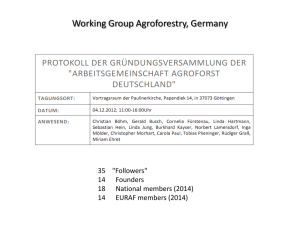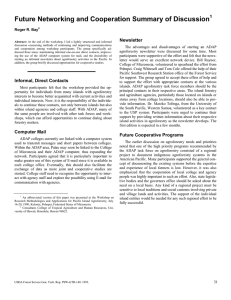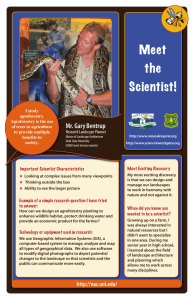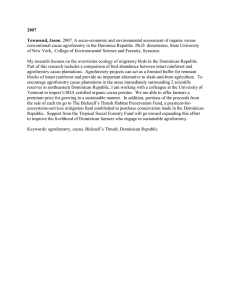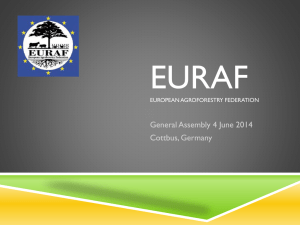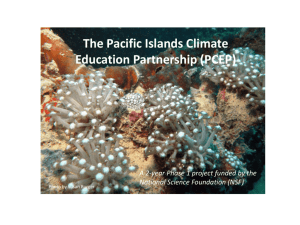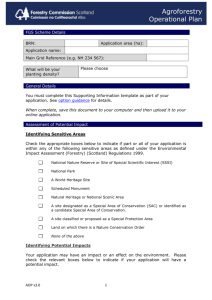Proceedings of the Workshop on Research Methodologies and Applications for Pacific
advertisement
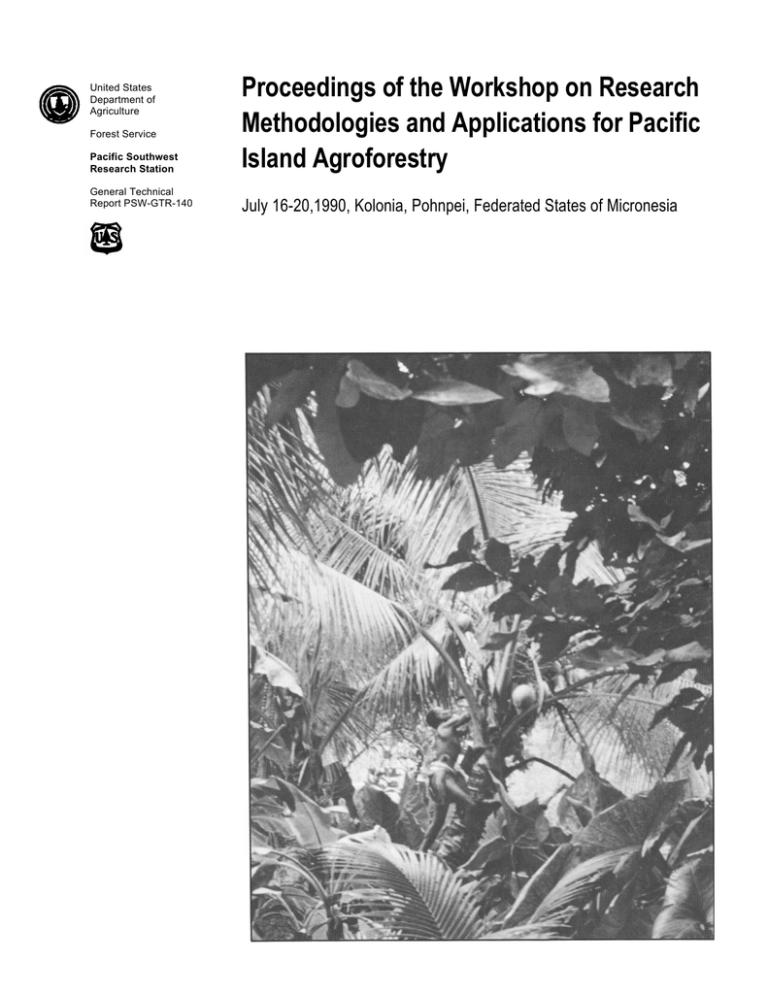
United States Department of Agriculture Forest Service Pacific Southwest Research Station General Technical Report PSW-GTR-140 Proceedings of the Workshop on Research Methodologies and Applications for Pacific Island Agroforestry July 16-20,1990, Kolonia, Pohnpei, Federated States of Micronesia Raynor. Bill; Bay, Roger R. technical coordinators. 1993. Proceedings of the workshop on research methodologies and applications for Pacific Island agroforestry; July 16-20, 1990; Kolonia, Pohnpei, Federated States of Micronesia. Gen. Tech. Rep. PSW-GTR-140. Albany, CA: Pacific Southwest Research Station, Forest Service, U.S. Department of Agriculture; 86 p. Includes 19 papers presented at the workshop, covering such topics as sampling techniques and statistical considerations, indigenous agricultural and agroforestry systems, crop testing and evaluation, and agroforestry practices in the Pacific Islands, including Micronesia, Northern Marianas Islands, Palau, and American Samoa. Retrieval Terms: Agricultural systems, cropping experiments, American Samoa, Micronesia, Northern Marianas, Pohnpei Island, Yap Technical Coordinators: Bill Raynor is a researcher in the Land Grant Programs, College of Micronesia, Kolonia, Pohnpei, Federated States of Micronesia. Roger R. Bay, formerly Director, Pacific Southwest Research Station, Forest Service, U.S. Department of Agriculture, Berkeley, Calif., is a consultant to the College of Tropical Agriculture and Human Resources, University of Hawaii, Honolulu, Hawaii. Cover. Yapese elder climbing a coconut tree. Photograph by Leonard A. Newell. Publisher: Pacific Southwest Research Station Albany, California (Mailing address: P.O. Box 245, Berkeley, CA 94701-0245 Telephone: 510-559-6300) February 1993 Proceedings of the Workshop on Research Methodologies and Applications for Pacific Island Agroforestry July 16-20, 1990, Kolonia, Pohnpei, Federated States of Micronesia Bill Raynor and Roger R. Bay, Technical Coordinators Contents Preface ...................................................................................................................................................................ii Needs and Priorities in Agroforestry Research in the Pacific Roger R. Bay ...................................................................................................................................................1 Analysis of an Agroforest: The Variable Radius Quadrat Method Harley I. Manner .............................................................................................................................................3 Permanent Field Plot Methodology and Equipment Thomas G. Cole ..............................................................................................................................................7 Statistical Considerations for Agroforestry Studies James A. Baldwin .......................................................................................................................................... 16 Socio-Cultural Studies of Indigenous Agricultural Systems: The Case for Applied Research Randall L Workman ..................................................................................................................................... 21 Economics and Agroforestry John W. Brown .............................................................................................................................................. 26 Future Networking and Cooperation Summary of Discussion Roger R. Bay ................................................................................................................................................. 31 A Review of Traditional Agroforestry in Micronesia Harley I. Manner ...........................................................................................................................................32 Micronesian Agroforestry: Evidence from the Past, Implications for the Future Marjorie V. C. Falanruw................................................................................................................................ 37 An Indigenous Pacific Island Agroforestry System: Pohnpei Island Bill Raynor and James Fownes .....................................................................................................................42 Yapese Land Classification and Use in Relation to Agroforests Pius Liyagel ..................................................................................................................................................59 Design and Analysis of Mixed Cropping Experiments for Indigenous Pacific Island Agroforestry Mareko P. Tofinga .......................................................................................................................................60 General Considerations in Testing and Evaluating Crop Varieties for Agroforestry Systems Lolita N. Ragus .............................................................................................................................................65 Documentation of Indigenous Pacific Agroforestry Systems: A Review of Methodologies Bill Raynor.....................................................................................................................................................69 Knowledge Systems in Agroforestry Wieland Kunzel .............................................................................................................................................75 Potentials of Integrating Spice Crops with Forestry in the Pacific Islands John K. Gnanaratnam ................................................................................................................................. 78 Agroforestry Programs and Issues in the Northern Marianas Islands Anthony Paul Tudela ..................................................................................................................................... 80 Agroforestry in Palau Ebais Sadang ................................................................................................................................................. 82 Indigenous Agroforestry in American Samoa Malala (Mike) Misa and Agnes M. Vargo ...................................................................................................... 83 Preface The increasing popularity of agroforestry as a land-use option in developing areas of the tropics has not gone unnoticed in the Pacific islands. So far, most of the agroforestry practices and technologies being introduced into the Pacific islands region are based on systems developed in Africa and Asia; for example, alley-cropping. Although these systems can be useful and have their applications in the region, we must also recognize the local indigenous agroforestry systems―systems developed over thousands of years of island experience. Agroforestry is a dominant form of agriculture on many islands, and systems vary widely from island to island, owing to differences in climate, topography, and culture. The scant research done in the recent past strongly indicates that these systems can offer the scientific community valuable insights into the development of sustainable agro-ecosystems, and, in many cases, can serve as foundations for future agricultural development. Indigenous agroforestry systems should be stud­ ied for several basic reasons: • The science underlying these systems is still not fully understood, but could prove valuable in the development of improved sustainable food production systems; • “Local technology transfer” from one island or region to another would be encouraged; • New discoveries of species, cultivars, and uses of plants could be important to world agriculture, medicine, and other areas; • Pride would be instilled in indigenous knowledge and practices and could encourage local innovation; • Interaction between researchers and practitioners/farm­ ers would be increased by putting the researcher out “in the field” to develop a better understanding of the practitioners’ problems! Time, however, is not on the researcher's side. Signs of disintegration of indigenous systems are everywhere―a decline in nutritional status among islanders, increased soil erosion and deforestation, and environmental pollution. Modem farming methods of monocropping and heavy use of pesticide and inor­ ganic fertilizers are being adopted and held in high esteem on most islands. Conversely, local knowledge is often seen as useless and backward, and is not being passed on to younger generations. Unfortunately, research is also hindered by a lack of available methodologies for the study of indigenous agroforestry. Existing research methods are varied and not well developed. What little quantitative research has been done has to a large part been carried out in research stations, an “artificial” environment where it is extremely difficult to simulate the complexity and diversity of indigenous systems. Furthermore, researchers, policymakers, and practitioners dis­ agree about research priorities. ii One result was the organization of this workshop by the newly formed Agroforestry Task Force of the USDA-funded Agricultural Development in the American Pacific Project (ADAP), with the assistance of the Institute of Pacific Islands Forestry of the Pacific Southwest Research Station; College of Micronesia Land Grant Programs; and Pohnpei State Depart­ ment of Conservation and Resource Surveillance. The workshop objectives were to: • Review concepts and evaluate current research on indig­ enous agricultural systems in the Pacific • Identify key research areas and priorities • Develop standardized research methodologies for agroforestry research in the Pacific • Establish a regional network for cooperative research. The island of Pohnpei was selected as the workshop site because indigenous agroforestry is the dominant agricultural land-use on the island (33 percent of the total land area), and the system has been relatively well-studied. Thirty-seven scientists and local resource management agency representatives attended from Pohnpei, Kosrae, and Yap in the Federated States of Micronesia; Republic of the Marshall Islands; Republic of Palau; Commonwealth of the Northern Marianas; Guam; Hawaii; Fiji; Western Samoa; American Samoa; Honolulu, Hawaii; and the continental United States. To say that the workshop, held July 26-30, 1990, in Kolonia, Pohnpei, accomplished all the objectives would be an exaggera­ tion. Many more questions and issues were brought up than were solved. On the other hand, this conference represented the first time that researchers, policy makers, and extension personnel in the American-affiliated Pacific have met together to discuss indigenous agroforestry and its relevance to current and future agricultural research and development. People met each other, and future working relationships were forged. Pacific island participants gained a better understanding of the researchers’ perspective, and researchers were able to get direct feedback on their activities from local policy-makers and extension special­ ists. The new bonds were formalized in the formation of the Pacific Agroforestry Network (PAN). As a result of this workshop, a new impetus has been given to research in indigenous agroforestry in the region. These proceedings provide a record of this important event as well as a collection of useful informa­ tion for people working in agroforestry research and extension in the Pacific and in other regions. Bill Raynor Land Grant Programs, College of Micronesia Kolonia, Pohnpei, Federated States of Micronesia Technical Coordinator USDA Forest Service Gen. Tech. Rep. PSW-GTR-140. 1993.
